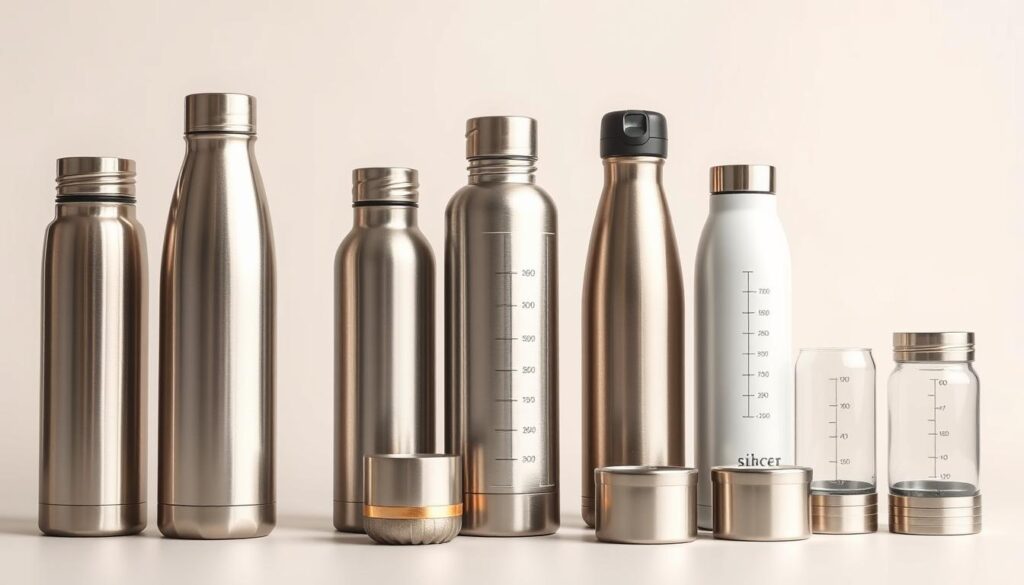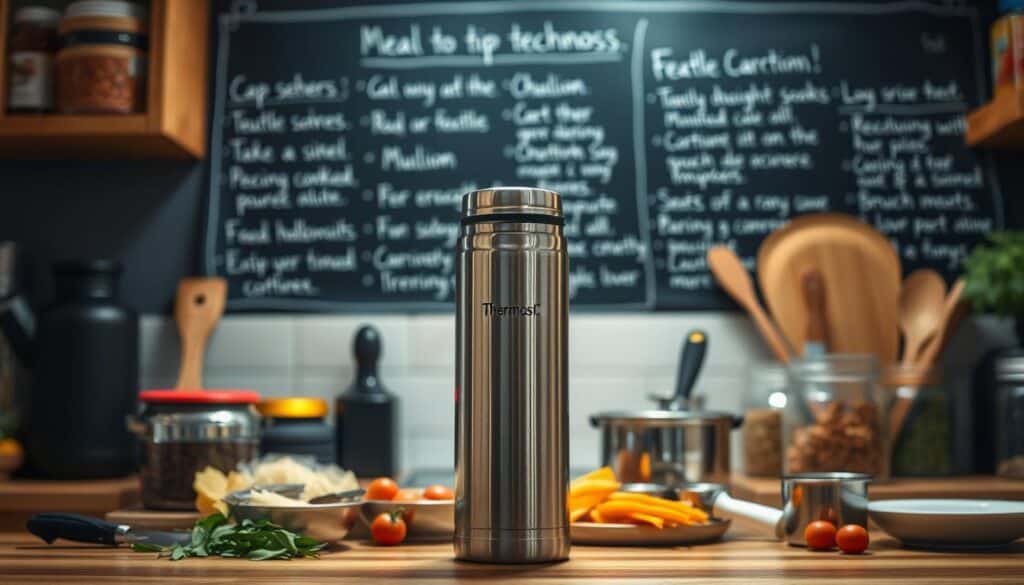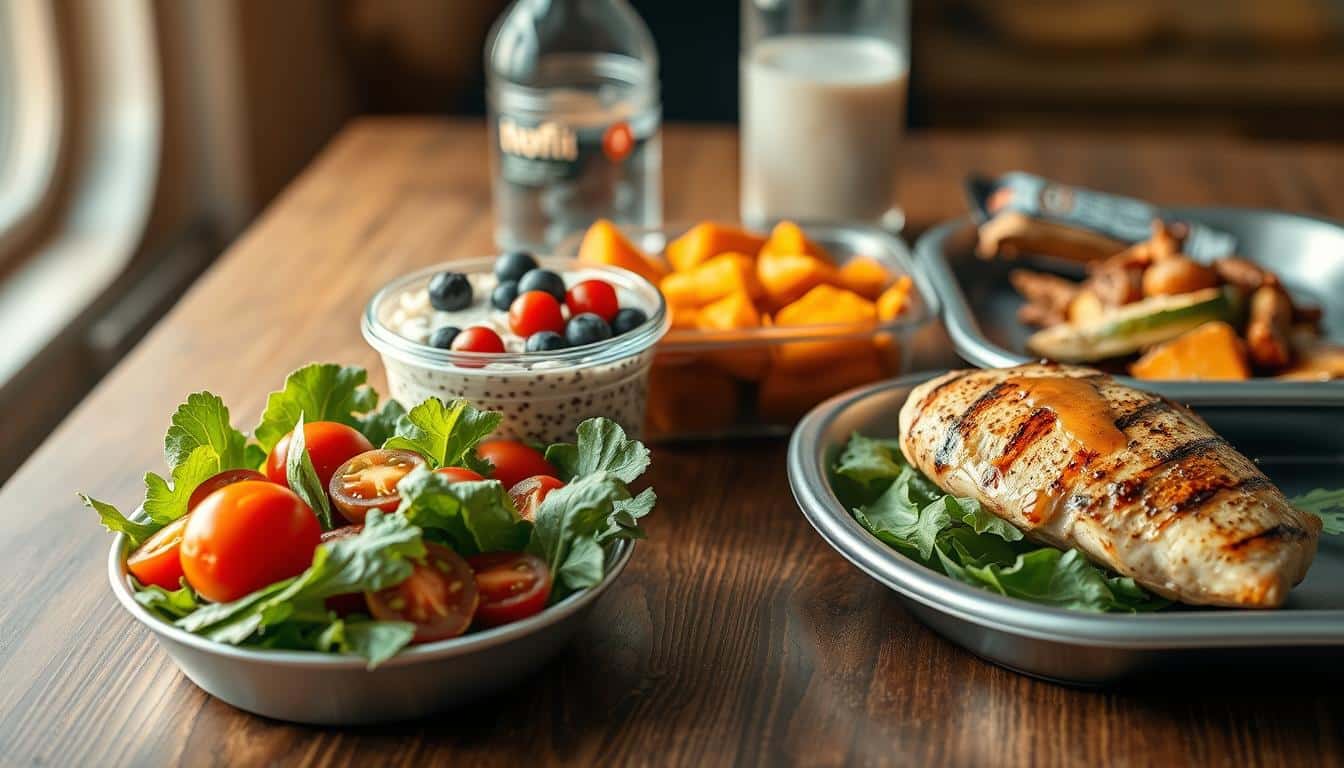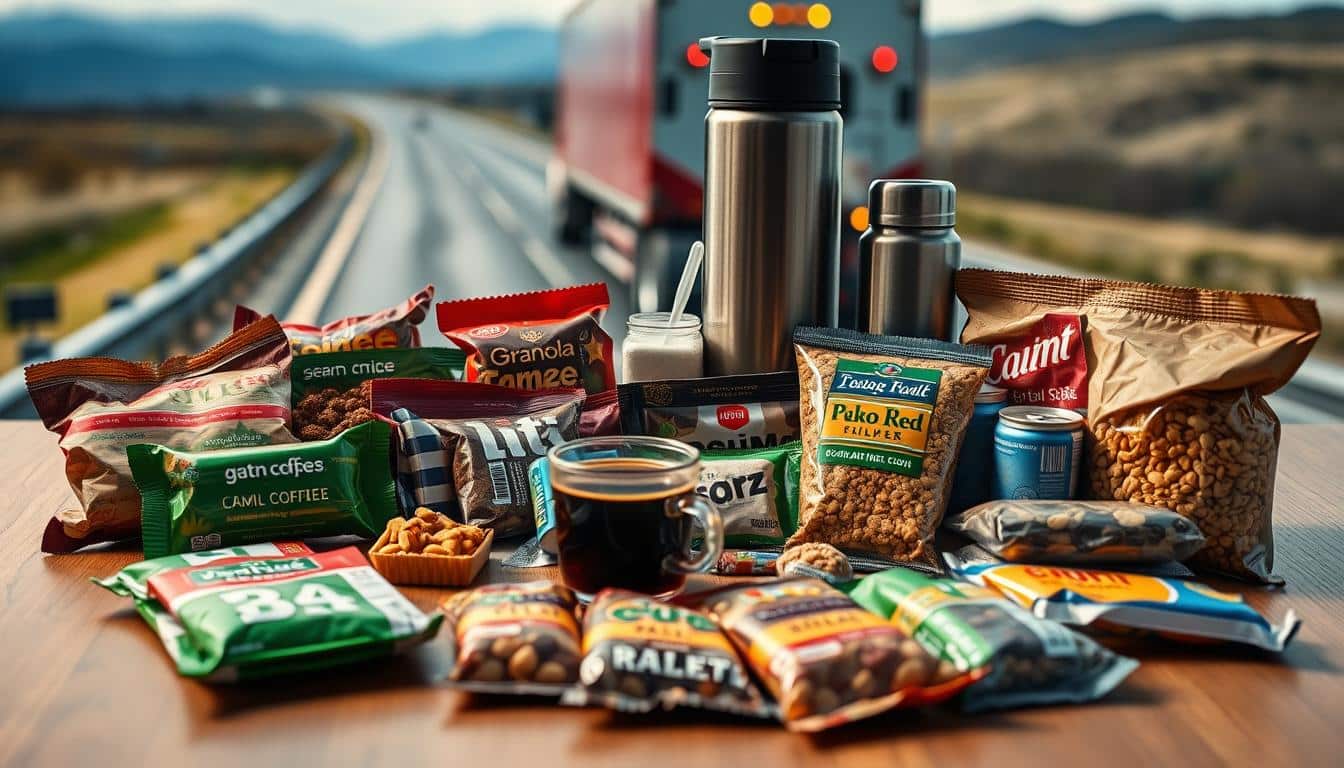Packing an insulated lunch changes your day. It’s great for various activities like working in a city, hiking, having meetings, or school lunches. This guide helps you pick the best thermal lunch gear for your lifestyle.
We compare food jars, thermos options, insulated lunch boxes, and soft coolers. They’re good for keeping food hot or cold, easy to carry, durable for daily use, and simple to clean.
This advice is based on tests from Serious Eats and The Spruce Eats, and tips from Backpacking Chef. It covers sizes, how well they keep things cold, and saving money and the environment over takeout. This article will guide you to reliable insulated lunches for meals away from home.
Why Thermal Lunch Solutions Matter for Commuters and Travelers
Thermal food jars and lunch bags have changed eating on the move. A good thermos keeps soup warm for many hours, and salads cold with ice packs. This keeps commuter lunches safe and gives travelers peace of mind all day.
The health and safety perks are clear. Vacuum-sealed containers, like those from Stanley and Thermos Stainless King, keep food at safe temperatures for hours. Their tight seals also stop leaks and protect food from bacteria, making them a smart pick for anyone on the move.
Taking meals from home saves money and is more convenient. With a thermos, you’ll spend less on takeout. It removes the hassle of finding food when you’re busy.
Choosing reusable items also helps the planet. Using thermoses and lunch bags cuts down on single-use waste. Products like Yeti Daytrip or Carhartt bags are made to last, helping you create less trash.
- Health tip: Preheat or pre-chill your thermos to keep food at the right temperature longer during your commute.
- Money tip: Keep track of the takeout meals you skip. It shows how fast a thermos pays for itself.
- Green tip: Pick gel-free reusable ice packs to lessen single-use waste and make cleaning easier.
Using these products has real benefits. Hikers can sip hot broth on chilly treks. Drivers won’t worry about spills from jars in their bags. These advantages make keeping lunches safe easier. They also cut down on daily single-use waste.
Top Types of Thermal Lunch Solutions: Food Jars, Lunch Boxes, and Soft Coolers
Deciding on the best thermal carry option depends on what you eat, how long you travel, and your packing style. Below are useful comparisons between three popular types. They’ll help you find the perfect gear for your daily needs.
Vacuum-insulated food jars are great for hot, single-item dishes like soup or pasta. Brands like Stanley and Thermos have options that keep food warm for hours. These jars, with wide mouths, make filling and stirring simple. They’re ideal for folks wanting a warm meal later in the day.
Insulated lunch boxes and soft coolers are perfect for varied meals. Carhartt and Hydro Flask offer structured models that protect your food. Yeti Daytrip coolers offer flexibility with durable insulation. Some come with dual compartments for both hot and cold food.
Freezable lunch bags use gel-lined walls for better cooling. PackIt lunch bags contain built-in gel panels that stay cold for hours. Yeti ColdCell Flex bags provide flexible yet strong cold keeping. These are great for meals that need to stay chilled.
- For soups that stay hot, vacuum-insulated food jars with long heat retention are best.
- Insulated lunch boxes or soft coolers are good for meals with sides since they prevent squashing.
- Choose freezable lunch bags or gel-lined coolers for keeping food cold all day.
Every option has its pluses and minuses: food jars focus on one dish, insulated lunch boxes offer balance, and soft coolers are easy to carry. Pick based on how much food you take and try your choice with your everyday routine first.
How Insulation Technology Works and What to Look For
Understanding insulation helps you choose the best gear for eating on the go. Different designs aim to slow down how quickly heat moves. They keep soups hot and salads cold. We’ll explain the main methods, materials, and types of closures. This way, you can compare features from brands like Stanley, Yeti, Thermos, Hydro Flask, Carhartt, and Sunnybird.
Double-wall vacuum insulation versus foam and foil layers
Double-wall vacuum insulation has an airless space between two walls. This barrier greatly lowers heat moving through and is best for stainless steel thermoses or food jars. It’s chosen for keeping things hot or cold for a long time.
Foam and multi-layer foil suit soft coolers and lunch bags well. Foam makes things bulkier and softer without being too stiff. Foil reflects heat, and using it with foam makes lunch bags work really well.
Materials: stainless steel, BPA-free plastic, nylon, polyester
Stainless steel, particularly 18/8, fights off smells and stains and can handle drops. It’s often used inside and outside many high-quality items. A stainless steel thermos also is super durable and easy to clean.
BPA-free plastic liners are light and easy to clean. Brands like Hydro Flask use these liners for their light weight and safety. Nylon and polyester outside offer protection against water and wear. Carhartt’s 600D polyester and Sunnybird’s nylon are top picks for tough, easy-to-clean surfaces.
Closures and seals: twist lids, magnet closures, zippers, and latches
Twist-on lids and screw caps generally offer the best leakproof seal for food jars and thermoses. Many lids also work as bowls, which is handy for eating straight from them. Stanley and Thermos have products that show off this feature.
Lunch boxes have different kinds of closures. Zippers are common but might get stuck or catch crumbs. Magnetic closures, like on the Yeti Daytrip, seal quickly but might open if the bag is too full. Latches are often the most durable. Serious Eats and other reviewers say latches last longer for everyday use. But, Carhartt and Hydro Flask make zippers that don’t snag easily.
- Look for strong seals and gaskets to stop leaks.
- Find lids that double as bowls to reduce the need for extra items.
- Choose the right insulation—vacuum for keeping things cold or hot longer, foam/foil for softer coolers.
Best Overall Food Jars and Thermoses for Long Heat Retention
Choosing the best thermos can make hot lunches easy on busy days. You’ll find notes here on options that are good all-around, from keeping things hot to lasting a long time. They are picked based on lab tests and feedback from real users. These are great for work, travel, and school.
Some thermoses stand out by keeping meals hot for hours on a commute. The Stanley Classic is known for being tough and keeping things hot or cold for ages. Its wide opening makes it easy to fill and clean, and you can use the lid as a cup. Tests prove it can keep contents hot for 15 hours and cold for 18. Made of recycled stainless steel, it’s leakproof and safe for the dishwasher.
The Thermos Stainless King is great for those looking to save money. The 16 oz version keeps things hot for 9 hours and cold for 14, just as promised. It comes with a folding spoon and a lid that can be used as a bowl, making it smart for adults who are watching their spending. Some units may show wear inside over time.
The Yeti food jar matches the best in keeping your food the right temperature and being tough. Some like its internal measures and that it’s safe for dishwasher use. Some users say Yeti is really good at keeping things cold or hot, but some find the MagVent lid hard to work with. Think about the lid design and how easy it is to open when picking between Yeti and Thermos Stainless King.
Parents look for thermoses for kids that are safe, light, and simple to use. The Thermos Funtainer fits the bill, being lightweight, easy to open, and completely leakproof. Heat stays for about 5–7 hours and cold for about 9 hours in testing, making it good for school lunches. It has a folding spoon and doesn’t get hot on the outside, but you need to clean the inside lid well to stop dirt from building up.
- Durability pick: Stanley Classic food jar — long retention, wide mouth, very tough.
- Value pick: Thermos Stainless King — strong insulation, practical lid and spoon.
- Premium pick: Yeti food jar — robust build, excellent insulation, consider lid preference.
- Kid-friendly pick: Thermos Funtainer — light, easy to operate, safe retention times.
Best Insulated Lunch Boxes and Soft Coolers for Daily Commuting
Finding the right insulated lunch box is all about balance. You need good insulation, the right size, and comfort in carrying. It’s crucial for commuters to have options that keep different meals safe, prevent leaks, and fit into their daily lives.
The Carhartt lunch bag is great for everyday use. It has two insulated areas to keep foods separate. A wide shoulder strap makes it easy to carry. In tests, it only lost 66% of its ice after eight hours, which is pretty good. It’s made of durable, water-repellent fabric and is light to carry, but cleaning can be tricky because of the two sections.
The Yeti Daytrip is a top choice for those who don’t mind spending more. It’s well-built and keeps your food cold. Tests show it loses 59% of its ice after eight hours. However, it doesn’t have a shoulder strap and might be too bulky for some. Still, it protects well against squash and has a good warranty.
The Hydro Flask lunch box is a practical choice. Its lined interior is easy to clean, making it great for messy lunches or daily use. It’s tough and keeps food chilled for hours. The Carry Out model is durable but heavier, and might not fit into slender bags as well.
The Sunnybird roll-top is perfect for those who like to travel light. Made of light nylon with a special interior, it keeps cold in very well. Its roll-top seal is strong, and it flattens for easy storage. In tests, it lost about 54% of its ice after eight hours, with some outer wetness and longer drying time. But it’s excellent for crowded travels.
- Carhartt lunch bag: dual compartments, shoulder strap, good all-rounder for mixed meals.
- Yeti Daytrip review: rigid protection, premium insulation, heavier but sturdy.
- Hydro Flask lunch box: easy-clean interior, durable under daily wear.
- Sunnybird roll-top: compact, collapsible, top performer for light commuters.
Choose a bag that fits your day. If you need to keep jars safe, go for something sturdy. If you use a tote, a roll-top like the Sunnybird works well. The Hydro Flask lunch box is great for those who prioritize cleaning and toughness. And for a mix of features plus an easy-to-carry design, the Carhartt lunch bag is your best bet.
Choosing the Right Size and Capacity for Your Meal Needs
Selecting the right thermal container is about matching your meal size to the container. A handy thermos size guide can help you pick the perfect one to keep your food at the right temperature. Too big, and you’ll lose heat; too small, and your food might get squished. You want something that’s just right for how much you eat.

Matching thermos capacity (16 oz vs 24 oz) to meal size
A 16-ounce thermos is great for adult lunches, packing enough room for a big soup or stew. Experts from The Spruce Eats and Backpacking Chef suggest these for single meals. For those who like more food or share, a 24-ounce thermos gives you more room without being too heavy.
Choosing between a 16 oz and a 24 oz? Remember, too much air makes food cool faster. Try to fill it up to keep your meal warm. For those who love to hike, the Thermos Stainless King 24-oz balances well between size and easy carrying.
Lunch box can capacity guidance (six-can capacity as a useful benchmark)
Testers at Serious Eats say a six-can capacity lunch box works well for everyday meals. It’s enough for a main dish, a snack, fruit, and a drink. Plus, it keeps everything steady while you carry it. Carhartt’s are bigger for longer days but might be too much for regular lunches.
Companies like Yeti and Sunnybird build their bags around this six-can size. It helps prevent your lunch from moving around too much. When picking a lunch carrier, consider this size whether it’s a bag or a box.
Avoiding dead space to prevent food from getting crushed or cooling faster
Empty space in your lunch box means food can get smashed. Avoid this by using dividers or tiny containers, or even napkins. Putting sandwiches in a separate spot keeps them safe from heavy items that could squash them.
If you’re using a soft-shell bag, try a roll-top to fit it snugly around your food. This trick keeps your food warm and stops things from moving around. Keeping your lunch packed tight is a simple tip to keep it just right.
Practical Testing Insights: Cold Retention, Cleaning, and Durability
Tests in the real world set our expectations for product performance and maintenance. Here are simple findings from testing top models against each other. These highlight their daily use behavior. Consider these points when looking at cold retention tests, lunch box cleaning advice, and lunch bag durability for travel or everyday use.
- Sunnybird Insulated Rolltop lost 54% ice in an eight-hour test, the best among the group.
- Yeti Daytrip showed 59% ice loss, with strong foil/foam layering for extended chill.
- Carhartt Insulated recorded 66% ice loss and held up well for mixed meals.
- Hydro Flask Carry Out reached 88% ice loss; PackIt and REI Packaway hit 100% melt in the same tests.
What this means for buyers.
Soft coolers that have great insulation, like Yeti’s ColdCell or Sunnybird’s foil layers, do better than many cheap ones. Use the results from cold retention tests to pick a bag that fits your trip and what you’ll carry.
Cleaning and stain resistance.
Interiors lined with hard plastic, like Hydro Flask’s, are easy to clean and don’t hold smells. But nylon and polyester like Carhartt and Sunnybird’s take longer to dry. They also hold moisture near the seams more.
- Bentgo stainless steel bento with a silicone lid resisted stains and odors and is dishwasher-safe (top rack recommended for lids).
- Seams, zipper tracks, and gasket areas are common trouble spots for lingering food. Follow basic lunch box cleaning tips: empty crumbs, rinse shortly after use, and air-dry fully.
Closure durability in daily use.
Zippers work smoothly on expensive models but can catch dirt and snag. Latches and magnets open and close more cleanly and quickly. Yet, overfilling can make magnets come loose and strain the seams on flexible cases.
- Serious Eats testing found latches easier to operate and maintain free of debris.
- High-quality zippers on Carhartt and Hydro Flask run smoothly but need occasional cleaning to avoid buildup.
- Test closure durability on lunch bags through real use: how they open, how much they carry, and use of shoulder straps show their weaknesses quicker than just looking at specs.
Quick practical checklist.
- Use cold retention test results to decide based on how long your trips are.
- Follow easy lunch box cleaning advice: wipe, rinse, and air-dry to keep away stains and smells.
- Choose latches or magnetic closures for easy upkeep; check zippers often if you use those.
Meal Prep Tips and Thermos Cooking Techniques for On-the-Go Meals
Smart packing and simple heat tricks turn a thermos into more than a travel cup. Use tight fills, preheat it, and time things right to keep meals hot. Or use these tricks to rehydrate dried foods. These methods are great for solo lunches, car trips, and short hikes.

Preheat and fill smart. Put boiling water in an empty stainless-steel thermos for 5–10 minutes. Then, throw out the water and add your hot meal. This method is great for hot soup and keeps the temperature just right.
- Use wide-mouth jars from Stanley or Thermos for easy use.
- Pack stews or fully cooked pasta while they’re still hot for the best results.
- A 24-oz jar can feed two if you add some small sides.
Dehydrated meals and soak timing. Dehydrated meals need more water and patience. Add 25–30% more boiling water than the instructions say. Then stir, close the lid, and wait. This might take 30 minutes to several hours, depending on what you’re making.
Cold-soak salads work differently. Let greens and grains soak up dressing for 1.5–2.5 hours. Couscous and quinoa are ready in about 1.5 hours. If you’re using pre-cooked dried pasta, it might take longer unless you add it near the end to avoid it getting too soft.
- Add pasta 20–30 minutes before you eat for the best texture.
- Put heavier grains at the bottom and delicate greens on top. This keeps textures right.
- Make sure to seal jars well and keep them upright until you eat.
Utensils and lids that double as bowls. Some Thermos and Stanley models have lids you can use as bowls. Bring a small reusable spork or spoon for convenience. This way, you save space and cut down on waste.
For trips with friends, bring a big food jar and small containers. Then everyone can use the lids or bowls to eat. These thermos tips help make mealtime easy and reduce trash whether you’re outdoors or at work.
Maintenance, Care, and Longevity of Thermal Lunch Solutions
Keep your thermos, lunch box, or cooler in great condition to save money and eat safely. Doing small things often stops bad smells and helps items last longer. Clean, check seals, and switch out parts to keep things working right.
Washing guidance
- Wash soft coolers and fabric bags by hand to protect them. Make sure they’re dry before you put them away.
- Check the guidelines before putting Stanley, Yeti, or Thermos jars in the dishwasher. Many are safe to clean this way.
- Wash lid interiors and small bits by hand to keep vacuum seals working well. These spots can hold a lot of dirt.
Removing stains and odors
- Make a paste with baking soda or use vinegar to get rid of stains and smells in stainless interiors.
- Hard plastic, like in Hydro Flask, is easy to clean and doesn’t hold odors.
- Soap and warm water work well on nylon and polyester, especially around zippers where crumbs gather.
Seal and hardware checks
- Look at silicone gaskets and lid seals every month. Replace them if they look damaged or don’t seal well to avoid leaks.
- Always check lids for leaks after you wash them. A bad lid can mean less heat kept in and more germs getting in.
- Examine zippers, latches, and magnets for signs of wear. Even though latches might last longer, some zippers also have a long life if cared for properly.
Gel inserts and long-term parts
- Change out gel inserts if they get hard or don’t keep things cold as they should.
- Think about getting a new bag if the gel pack in it doesn’t work well anymore.
- Having extra seals and lids for jars and bags you use a lot makes them last. Changing an old gasket can make a thermos seal like new quickly.
Daily habits for lasting results
- Empty and clean containers right after eating. This stops stains and keeps your lunch bag fresh.
- Keep containers open and dry when stored to stop mold from growing.
- Soft brushes and gentle cleaners are best. Harsh cleaners can scratch and damage the inside.
Conclusion
This summary offers the best picks after reviewing and testing thermal lunch options. The Stanley Classic Legendary Food Jar shines for its durability and keeping food hot or cold. The Thermos Stainless King brings great value. Yeti models impress with high performance tailored for adults. The Carhartt Insulated Classic, Yeti Daytrip, Hydro Flask Carry Out, and Sunnybird roll-top are top choices for daily use. Their quality has been confirmed by rigorous tests similar to those by Serious Eats.
When picking a thermos or lunch box, think about how much you eat. A 16 oz size fits a normal lunch, while a 24 oz is good for bigger meals or to share. Choose lunch boxes that avoid wasted space, hold enough for your needs, shield delicate foods, and seal tightly to keep everything inside. These tips lead to more dependable and mess-free meals on the move.
For the best experience, warm up or cool down your containers before use. Use smaller containers or dividers to keep food from getting squished. Keep the seals and inside of your lunch gear clean to maintain its performance. Exploring meal prep methods like dehydrating or cold-soaking can save money. It also reduces the use of single-serving packaging, which is good for adventurers and commuters.
FAQ
What are the main benefits of using thermal lunch solutions for commuters, travelers, hikers, and parents?
How long will food stay hot or cold in a vacuum-insulated food jar?
Should I get a 16 oz or 24 oz food jar?
What’s the best lunch-box capacity for daily commuting?
How do vacuum insulation, foam, and foil layers differ?
Which materials are best for durability and easy cleaning?
Are magnetic closures, zippers, or latches better for lunch boxes?
Which food jars are recommended for long-term heat retention and rugged use?
How do insulated lunch boxes and soft coolers compare for mixed meals?
What do cold-retention tests show about top lunch boxes?
How do I pack hot soups or stews for best temperature retention?
Can I use a thermos to cook dehydrated or cold-soak meals?
Are thermoses and insulated boxes safe for food storage long-term?
How should I clean and maintain thermal jars and lunch boxes?
When should I replace seals, lids, or gel inserts?
Will using thermoses and insulated lunch boxes save me money and reduce waste?
What small extras improve the on-the-go meal experience?
Content created with the help of Artificial Intelligence.



